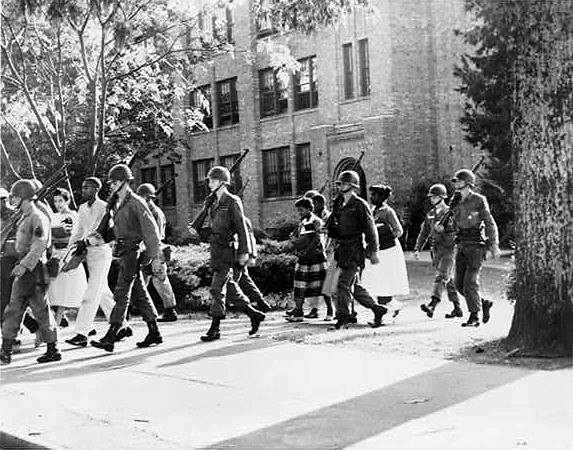|
With the decision made in Brown v. Board of Education in 1954 of segregation in schools being unconstitutional, many black
students began to attend previously all white schools for the first time. The NAACP once again stepped in and began to help
black families enroll in the previously all white schools, a case of this in Little Rock, Arkansas drew high public attention.
When approached by delegates of the NAACP about complying with the desegregation, Little Rock Board of Education agreed
to allow a select set of students to attend Central High School because of their high grade records. The nine students were;
Thelma Mothershed, Minni-Jean Brown, Elizabeth Eckford, Gloria Ray, Jefferson Thomas, Melba Pattillo, Terrence Roberts, Carlotta
Walls,Ernest Green. As news spread of the black students' plans to attend the all white school, a group of citizens known
as "segregationist" began to protest the students enrollment in to the school and even began to plan a blockade
outside of the entrance of the school.
On September 4, 1957, Little Rock Governor Orval Faubus issued the Arkansas National Guard to assist the "segregationists".
This sparked anger across the U.S., even causing President Eisenhower to request a meeting with Faubus about how he should
not come into conflict with the Supreme Court's decision of desegregation. Next on September 20, the U.S. Justice Department
granted an injunction that removed the National Guard from the "segregationist".
On the morning of September 23 parents of the students attending Central High turned into protesters standing outside
the school blocking the way of the students but with Little Rock Police escorts the students slipped in to the school. As
the protesters outside learned of the students' attendance in the school, they began a riot that the police officers could
not control, the students were removed as a result.
|
|
 |
|

The next morning, Mayor Woodrow Mann requested the accompaniment of federal troops for the students. Over night the same members
of the Arkansas National Gaurd that had been there previously were positioned outside of the school but with a different cause
this time, to protect the Little Rock Nine. On September 25, with the protection of the National Guard, the eight of the nine
students entered the school unharmed. One student, Elizabeth Eckford, was not notified of the escorts that the students were
being given before entering the school and she tried entering from the side. Eckford was verbally harassed by a large group
protesters outside of the school before she made it in the school. This routine pursued for the next five days until the most
of the protesters gave up and allowed the integration in Central High to continue, but this was no the end of the students'
strife.
Throughout the first part of the school year the students were verbally and sometimes even physically harassed by the
other white students that were under the influence of their parents. Most of the physical harassment was spitting or pushing,
but one notable incident happened to Melba Pattilo. As Pattilo was walking down the hallway in late November of 1957, she
heard a male student yell the word "Nigger" at her and when she looked up the boy threw acid into her eyes, causing
minor damage to her corneas. Another incident occurred between Minni-Jean Brown and a group of white students at lunch. The
group of students began to verbally harass Brown, Brown was tired of the antagonizing from the other students and simply got
up and poured her chili on the group of students. Brown was suspended from the school for violence but later transferred to
New Lincoln High School in New York.
With the commotion happening at a daily rate at the high school the Little Rock Board of Education decided to end the
school year short of the last half instead of continuing the integration efforts. Within the next year an average of one thousand
students dropped out of the district and enrolled in to all white private schools. After several court hearings on what to
do next, the school board decided to reopen the schools with an integrated system intact.
|
 |
|
|
|
